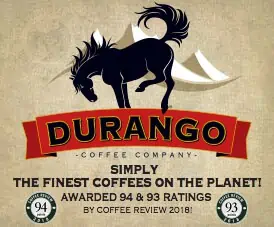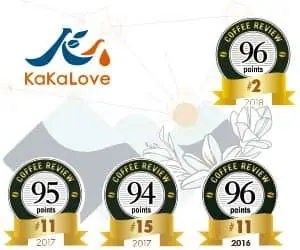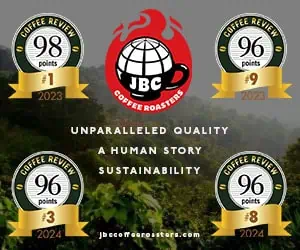Spicy, perhaps smoky tones enliven the rich top notes of the aroma and carry into the cup. Surprisingly clear acidity, fine body, long finish, superb aftertaste.
I wouldn't have expected a coffee so subtle to stand up to a dark roast so well. The roast only slightly mutes the heady floral tones of the aroma, while the acidity in tantalizing Yirgacheffe fashion hovers between flower and fruit. The body is hardly robust, but substantial enough to support the top notes. Only a trace of carbon.
This rich, deeply dimensioned, complex version of the great Guatemala profile happily combines clear, wine-toned acidity with satisfying dark-roast pungency. I even detected a hint of the famous Antigua smokiness smoldering somewhere inside the pungency.
A model Mandheling: Low-toned, heavy-bodied, balanced, mouth-filling. Some carbon, but buffered by depth and richness. Enough acidity makes it through the roast to keep the deep bottom of the coffee from sagging into boredom.
Some winy notes flirt from inside the dark-roast pungency. Otherwise an unremarkable but solid dark-roast coffee: balanced, without sharpness, and nearly carbon-free.
Extends from a deep, rich bottom to acidy, wine-elevated notes at the top. The usual Starbucks carbon tones are pleasantly lost in the expansive complexity of the coffee until the aftertaste, when they surface after the rest of the profile has passed into memory.
This ingratiating dark roast comes straight at us, forgoing drama and intrigue. Not much Sumatra-style resonance behind its first sweet-pungent impression, but balanced and pleasing.
First pungent then complex, the aroma is full of intrigue. We get a bit less in the cup, but given the darkness of the roast what remains is still impressive: enough acidity to keep the body lively, and generally an admirable balance between the qualities of the coffee and the impact of the roast.
Dark fruit (prune?) tones complicate a solid, balanced, dark-roast character. Some carbon at the top of the profile, but good Indonesia richness underneath. The carbon dominates in the aftertaste.
Hard, high notes surprise in both aroma and cup, persisting into the aftertaste. But if you taste attentively the fundamental, Indonesian matrix of the coffee emerges beneath the sharpness: rich, subtly low-toned, balanced, with some tones that even could be called chocolate. In the first round of cupping the sharp notes seemed to energize the coffee; in the second they just tasted sharp.
Depending on whether your palate reads the fermented notes as pleasantly fruity or disagreeably cloying, you could love or loath this coffee. If you think you might love it, ignore the rating, which deducts for the ferment. Under the impact of the dark roast the ferment turns lush, almost spicy. Displays the usual Indonesia virtue of solid body.










